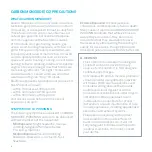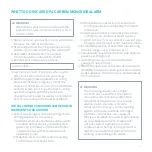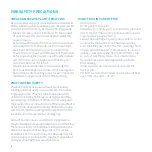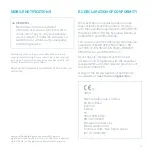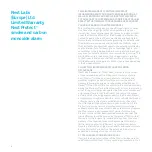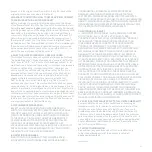
26
•
Extreme Exposure:
Unconsciousness,
convulsions, cardiorespiratory failure, death.
• Many cases of reported CARBON MONOXIDE
POISONING indicate that while victims are
aware they are not well, they become so
disoriented that they are unable to save
themselves by either exiting the building or
calling for assistance. Young children and
household pets are usually the first affected.
WARNING
This carbon monoxide alarm is designed
to detect carbon monoxide from any
source of combustion. It is NOT designed
to detect any other gas.
Individuals with certain medical problems
should consider using detection devices
with lower COHb alarm capabilities and
consider warning devices that provide
audible and visual signals for carbon
monoxide concentrations of under 30 ppm.
Installation of the apparatus should
not be used as a substitute for proper
installation, use and maintenance of fuel-
burning appliances, including appropriate
ventilation and exhaust systems.
This apparatus is designed to protect
individuals from the acute effects of
carbon monoxide exposure. It will not
fully safeguard individuals with specific
medical conditions. If in doubt, consult
your doctor.
CARBON MONOXIDE (CO) PRECAUTIONS
WHAT IS CARBON MONOXIDE?
Carbon Monoxide (CO) is an invisible, odourless,
tasteless gas produced when fuels do not burn
completely, or are exposed to heat (usually fire).
These fuels include: wood, coal, charcoal, oil,
natural gas, gasoline, kerosene and propane.
Common appliances that are often sources
of CO include oil or gas burning boilers, gas
ovens, wood-burning fireplaces, and charcoal
grills. If they are not properly maintained, are
improperly ventilated or malfunction, CO levels
can rise quickly. Additional sources include
space and water heating, cooking, uncontrolled
burning, tobacco smoking, internal combustion
engine. CO is a real danger now that homes are
more energy efficient. “Air-tight” homes with
added insulation, sealed windows, and other
weatherproofing can “trap” CO inside.
Electrical appliances typically do not produce CO.
Nest Protect will alarm:
• within 3 minutes at 300 ppm CO
• within 40 minutes at 100 ppm CO
• within 90 minutes at 50 ppm CO
Unit will not sound before 120 minutes of
exposure at 30 ppm.
SYMPTOMS OF CO POISONING
The following symptoms are related to CARBON
MONOXIDE POISONING and are to be discussed
with ALL members of the household:
•
Mild Exposure:
Slight headache, nausea,
vomiting, fatigue (often described as
‘Flu-like’ symptoms).
•
Medium Exposure:
Severe throbbing
headache, drowsiness, confusion, fast
heart rate.
Summary of Contents for S3003LWES
Page 32: ...A13 64 10 0036 GB A ...















